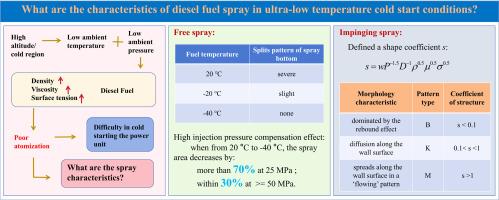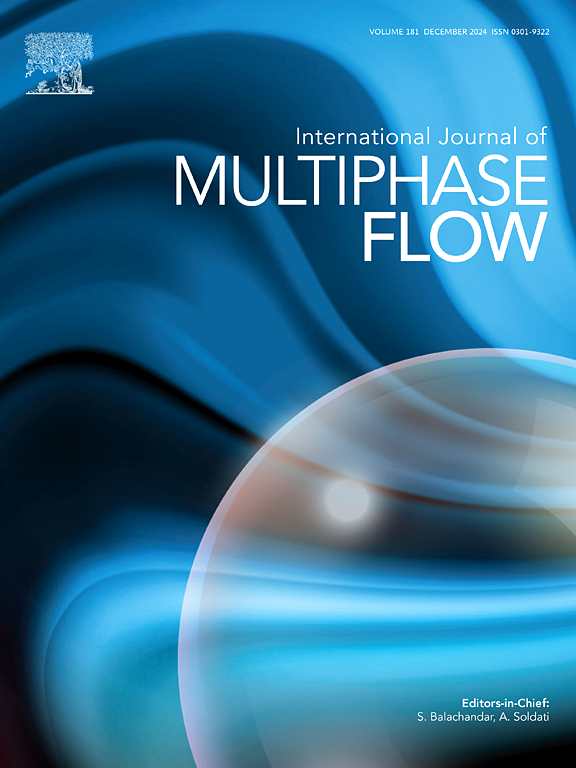Study on free and impinging diesel spray macroscopic characteristics under extreme-low fuel temperature conditions
IF 3.8
2区 工程技术
Q1 MECHANICS
International Journal of Multiphase Flow
Pub Date : 2025-10-02
DOI:10.1016/j.ijmultiphaseflow.2025.105474
引用次数: 0
Abstract
Spray characteristics have a significant regulatory effect on the combustion process of internal combustion engines, especially under cold start conditions. The macroscopic characteristics of free spray and impinging spray are investigated experimentally. Darker coloured enriched clusters appear at the bottom of free spray. The splits at the bottom of free sprays are severe, slight and none split at 20 °C, -20 °C and -40 °C, respectively. In the 0 to 466.62 μs after start of injection (ASOI), the spray area is decreased by >70 % at a low injection pressure of 25 MPa when the temperature drops from 20 °C to -40 °C, and by <30 % when the injection pressure >50 MPa. The impinging spray is divided into four regions: liquid core region, free jet region, wall jet region, and transition region. The spray in the transition region should be the focus of the combustion optimisation. A new dimensionless number s is defined as the shape coefficient of impinging spray. B-shaped when s < 0.1, K-shaped when 0.1 < s < 1, and M-shaped when s > 1. At 1333.20 µs after impinged the wall (AIMW), the maximum diffusion distance decrease by 19.94 % and the maximum entrainment height decrease by 24.59 % at 25 MPa when the fuel temperature decreases from 20 °C to -40 °C, for 37.73 % and 35.89 % at 100 MPa. The results can provide new insights for multiphase flow modelling, and a theoretical basis can be provided for the design of fuel injection systems for low-temperature suitability.

极低燃油温度条件下自由与冲击柴油机喷雾宏观特性研究
喷淋特性对内燃机的燃烧过程具有显著的调节作用,特别是在冷启动条件下。对自由喷雾和撞击喷雾的宏观特性进行了实验研究。在自由喷雾的底部出现颜色较深的富集簇。在20°C、-20°C和-40°C条件下,自由喷雾底部劈裂严重、轻微和不劈裂。在开始喷射后0 ~ 466.62 μs (ASOI)内,当温度从20℃降至-40℃时,低喷射压力为25 MPa时,喷射面积减小了70%,当喷射压力为50 MPa时,喷射面积减小了30%。将冲击喷雾分为液核区、自由射流区、壁面射流区和过渡区四个区域。过渡区喷雾应成为燃烧优化的重点。定义了一个新的无量纲数s作为碰撞喷雾的形状系数。s <; 0.1时为b型,0.1 < s <; 1时为k型,s >; 1时为m型。在撞击壁面1333.20µs (AIMW)时,当燃料温度从20℃降至-40℃时,在25 MPa下,最大扩散距离和最大夹带高度分别下降了19.94%和24.59%,在100 MPa下分别下降了37.73%和35.89%。研究结果可为多相流建模提供新的思路,并为低温适用性燃油喷射系统的设计提供理论依据。
本文章由计算机程序翻译,如有差异,请以英文原文为准。
求助全文
约1分钟内获得全文
求助全文
来源期刊
CiteScore
7.30
自引率
10.50%
发文量
244
审稿时长
4 months
期刊介绍:
The International Journal of Multiphase Flow publishes analytical, numerical and experimental articles of lasting interest. The scope of the journal includes all aspects of mass, momentum and energy exchange phenomena among different phases such as occur in disperse flows, gas–liquid and liquid–liquid flows, flows in porous media, boiling, granular flows and others.
The journal publishes full papers, brief communications and conference announcements.

 求助内容:
求助内容: 应助结果提醒方式:
应助结果提醒方式:


